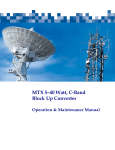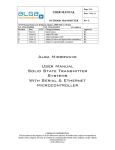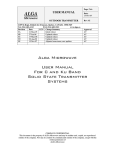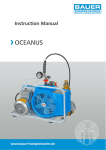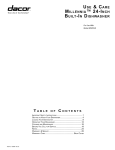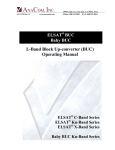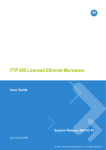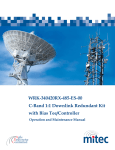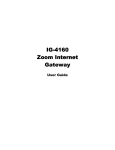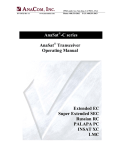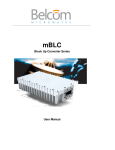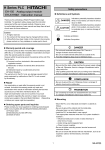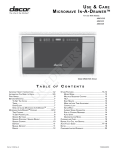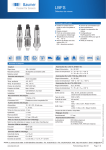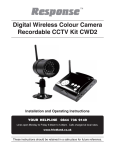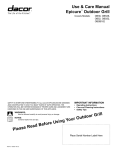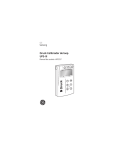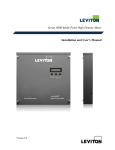Download MTX 5–40 Watt, C-Band Block Up Converter
Transcript
MTX 5–40 Watt, C-Band Block Up Converter Operation & Maintenance Manual mitecVsat. Designers and manufacturers of telecom products 16715 Boulevard Hymus Kirkland, Quebec, Canada, H9H 5M8 OPERATION AND MAINTENANCE MANUAL Preliminary Released REVISION RECORD Revision ECN # Description Date 0 Engineering Release. 27 Mar 07 1 Logo update 19 Oct 12 2 Moved accessories to appendix A 15 Nov 12 3 Updated building address 10 Jan 13 Approved MTX 5-40 Watt C-Band Block Up Converter This document contains information proprietary to mitecVsat., or its affiliates, or to a third party to which mitecVsat. may have a legal obligation to protect such information from unauthorized disclosure, use, or duplication. Any disclosure, use, or duplication of this document or of any of the information contained herein is expressly prohibited except as mitecVsat. may otherwise agree in writing. Designer: Technical Writer: Date: 27 Mar, 2007 Date: 01 Mar 2012 DOCUMENT NO. REV 3 219363-001MA PAGE 3 OF 73 mitecVsat Table of Contents Table of Contents TABLE OF CONTENTS.........................................................................................I PREFACE ..............................................................................................................I 1. INTRODUCTION .........................................................................................3 1.1 Receiving and Inspection .........................................................................................4 1.1.1 Equipment Damage or Loss .............................................................................4 1.1.2 Return of Equipment ........................................................................................4 1.2 Preparing for Installation ........................................................................................5 1.2.1 Safety Precautions ............................................................................................5 2. INSTALLATION & OVERVIEW .................................................................7 2.1 General Description .................................................................................................7 2.2 Features .....................................................................................................................8 2.3 Options ......................................................................................................................8 2.4 Specifications ............................................................................................................9 2.4.1 Controls and Indicators...................................................................................12 2.4.2 General Considerations ..................................................................................12 2.5 Interfaces .................................................................................................................12 2.6 Basic Mechanical Characteristics .........................................................................15 2.6.1 External View of the BUC Module ................................................................15 2.6.2 Connections and Mounting Hardware............................................................16 2.7 Assembly and Installation......................................................................................17 2.7.1 Lifting the BUC Module into Position and Temporary Attachment..............18 2.7.2 Securing the BUC Module .............................................................................18 2.8 Functional Overview ..............................................................................................20 2.8.1 IF/RF Conversion and Amplification .............................................................20 2.8.2 Protection and Control....................................................................................20 2.8.3 Communication Protocols ..............................................................................21 3. BUC OPERATION......................................................................................23 mitecVsat Table of Contents 3.1 Procedure ................................................................................................................23 3.2 Connector Interface ...............................................................................................24 4. REDUNDANCY OPERATION....................................................................25 4.1 General Description ...............................................................................................25 4.1.1 1:1 Redundant System MRK-596443-ES-11 .................................................25 4.1.2 Redundant Mode Control Mechanism and Criteria........................................26 4.2 Operating Modes ....................................................................................................26 4.3 Serial Interface Controls and Indicators..............................................................27 4.4 Redundancy System Assembly..............................................................................27 5. MAINTENANCE ........................................................................................29 5.1 Preventive Maintenance.........................................................................................29 5.1.1 Procedure ........................................................................................................29 5.1.2 BUC Module System Preventive Maintenance..............................................29 5.1.3 BUC Module Cooling System Preventive Maintenance ................................29 5.1.4 Performance Check.........................................................................................31 5.1.5 Troubleshooting..............................................................................................31 5.1.6 Out-of Warranty Repair..................................................................................32 5.1.7 Preventive maintenance..................................................................................32 APPENDIX A ......................................................................................................33 Power supply and redundancy kit options. ................................................................33 APPENDIX B ......................................................................................................35 Serial Protocol Documentation. ..................................................................................35 APPENDIX C ......................................................................................................37 Access via Ethernet/SNMP Interface..........................................................................37 Required pre-setting on the PC...................................................................................37 BUC connected to a PC / Laptop. ...............................................................................37 BUC connected to LAN................................................................................................38 Web Access....................................................................................................................39 APPENDIX D ......................................................................................................47 mitecVsat Table of Contents SNMP.............................................................................................................................47 APPENDIX E ......................................................................................................49 Spare Parts ....................................................................................................................49 List of Tables Table 1 - Specifications .......................................................................................................9 Table 2 – Connector Interface ...........................................................................................13 Table 3 - DC Input – J3 .....................................................................................................13 Table 4 - AC Input – J3 .....................................................................................................13 Table 5 - User RS-485/232/Ethernet/SNMP/User Discrete interface – J4........................14 Table 6 - Redundant Interface – J6....................................................................................14 Table 7 - Recommended Corrective Actions.....................................................................32 Table 8 - Indoor Rack Mount 150W Power Supply ..........................................................33 Table 9 - Indoor Rack Mount 480W Power Supply ......................................................33 Table 10 - Outdoor 480W Power Supply ..........................................................................33 Table 11 - Redundancy Kit for 8W, 16W, 20W, BUC Systems........................................34 Table 12 - BUC connected to a PC / Laptop .....................................................................37 Table 13 - BUC connected to a LAN.................................................................................38 Table 14 –SNMP configuration .........................................................................................47 List of Figures Figure 1 - a) 5-10W C-Band BUC b) 20-40W C-Band BUC.............................................3 Figure 2 - AC or DC isolated operated ................................................................................3 Figure 3 – Ordering Information .........................................................................................8 Figure 4 – Detail interfaces for the BUC system...............................................................12 Figure 5 – Mechanical detail 5/10W BUC ........................................................................15 Figure 6 – Mechanical detail 20/40W BUC ......................................................................16 Figure 7 - Recommended Distance for Mounting on the Hub...........................................19 Figure 8 – High Level Block Diagram of the BUC ...........................................................20 Figure 9 - 1:1 System Block Diagram ...............................................................................25 Figure 10 - Cooling Fan Replacement ...............................................................................30 Figure 11 - RJ45 pin configuration....................................................................................38 Figure 12 - Home page ....................................................................................................40 Figure 13 - Configuration of the Ethernet/SNMP parameters..........................................41 Figure 14 - BUC telemetry ...............................................................................................42 Figure 15 - Up link Redundancy system telemetry ..........................................................43 Figure 16 - Alarm Log events: (Non chronological events).............................................44 Figure 17 - Help page. Under development......................................................................45 mitecVsat Preface Preface Scope This document covers the installation, operation, and maintenance of the MTX 5-40 Watt C-Band Block Up Converter. It contains information intended for engineers, technicians and operators working with the BUC module. To make inquiries, or to report errors of fact or om ission in this docum ent, please contact the technical writing department at mitecVsat. at (514) 694-8666. IMPORTANT Important information concerning the operation and care of this product, as well as safety authorized operators is highlighted throughout this document by one of the following labels: NOTE Indicates a reminder, a special consideration, or additional information that is important to know. CAUTION! Identifies situations that have the potential to cause equipment damage. WARNING!! Identifies hazardous situations that have the potential to cause equipment damage as well as serious personal injury. of mitecVsat Introduction 1. Introduction The Block Upconverter (BUC) is a highly reliable, high quality, cost efficient unit designed for use in VSAT applications. This line of products, using state of the art technology, is characterized by unparalleled durability and dependability. The BUC also has high linearity and gain stability over the full operating temperature range. The standard output operating frequency range is 5.850 GHz to 6.425 GHz. Other frequency options ar e also available ranging from 5.725GHz to 7.025GHz. Refer to Table 1 - Specifications. a) b) Figure 1 - a) 5-10W C-Band BUC b) 20-40W C-Band BUC Figure 2 - AC or DC isolated operated Rev 3 Page 3 mitecVsat 1.1 Introduction Receiving and Inspection The BUC module is designed to function outdoor and will arrive in a standard shipping container. Immediately upon receipt of the BUC m odule, check the Bill of Lading against the actual equipment you have received. Inspect the shipping container exteriors for visible dam age incurred during shipping. CAUTION! Handle the BUC module with extreme care. Excessive shock may damage BUC module’s delicate internal components. NOTE Before unpacking the shipping containers, move them near to the site where the system will be mounted. Ensure that the containers are oriented correctly in accordance with the “This Side UP” labels. Carefully remove the BUC module and packing material from the shipping containers. Using the supplied packing list, verify that all items have been received and undam aged during shipment. Verify that all items are complete. If there are any omissions or evidence of im proper packaging, please notify mitecVsat. immediately. 1.1.1 Equipment Damage or Loss mitecVsat. is not responsible for dam age or loss of equipment during transit. For further information, contact the responsible transport carrier. When declaring equipm ent as dam aged during transit, preserve the original shipping cartons facilitate inspection reporting. to 1.1.2 Return of Equipment When returning equipment to mitecVsat for repair or replacement: 1. Identify, in writing, the condition of the equipment, 2. Refer to the sales order, Purchase Order and the date the equipment was received. Notify mitecVsat Sales Adm inistration Department of the equipm ent condition and obtain a Return Material Authorization (RMA) num ber and shipping instructions. m itecVsat will pay for the cost of shipping the product to the customer after the repairs are completed. Rev 3 Page 4 mitecVsat Introduction NOTE Do not return any equipment without an RMA number. This is important for prompt, efficient handling of the returned equipment and of the associated complaint. 1.2 Preparing for Installation Before attempting to install or use the BUC m odule, we recom mend that y ou first fam iliarize yourself with the product by reading through th is manual. Understanding the operation of the system will reduce the possibility of incorrect installation, thereby causing damage or injury to yourself or others. The BUC module must be installed in accordance with the conditions and recommendations contained in the following sections. When you are ready to begin your installation, use the information in Chapter 2 (Installation) as a guide for making all the required electrical connections. 1.2.1 Safety Precautions Carelessness or mishandling of the BUC m odule may damage the unit causing serious injury to yourself or others. Please adhere to the following: WARNING!! To avoid personal injury, always ensure that the waveguide port is properly connected before applying RF power to the system. Rev 3 Page 5 mitecVsat Installation & Overview 2. Installation & Overview 2.1 General Description This section describes the installation and theory of operation of the BUC module. The stand-alone 5/10W BUC is powered from a +18 to +55 VDC or 90 to 260 VAC power source and the 20/40W BUC from +32 to +55VDC or 90 to 260 VAC power source. The BUC amplifies an input signal from an L-Band RF source up to a power level of 40W Watts in CBand. The BUC is capable of providing an output le vel of 5W, 10W, 20W or 40W, and is equipped with over tem perature shut down and protec tion circuits. The 5W and 10W BUCs are incorporated in housing designed for convection cooling so that no additional cooling fan is required to prevent the internal electrical co mponents of the unit from over-heating. The 20W and 40W BUCs have a fan to prevent from over heating. The BUC is for outdoor use and is secured onto a mounting frame by the WR137G (Grooved) waveguide attached to the RF output and by up to four #10-32 threaded m ounting holes opposite to the RF output. Two additional mounting holes are available one on each side of the unit. The Low Power C-Band BUC product line comes with different optional interfaces. They are mainly 6 configuration categories: 1. BUC’s equipped with DC powered through the coaxial IF connector, have part num ber suffixes: -2xxx. 2. BUC’s equipped with DC (isolated) pow number suffixes: -4xxxx. 3. BUC’s equipped with AC powered through an MS connector, have part number suffixes: -7xxx. 4. BUC’s equipped with FSK1 M&C, have part number suffixes: -xx1x. 5. BUC’s equipped with RS232/RS485/Ethernet/SNMP M&C, have part number suffixes: xx5x. 6. BUC’s equipped with Redundancy function2 have part number suffixes: -xxx1. ered through an MS connector, have part NOTE 1 FSK M&C is not available on RS232/RS485/Ethernet/SNMP M&C and Redundancy ready model. NOTE 2 Redundancy ready model is not available with DC powered through the coaxial IF connector or AC power supply. Rev 3 Page 7 mitecVsat Installation & Overview For other possible configuration consult factory. Figure 3.0 shows the Ordering Information: MTX - FFFF PP – E N – 2 0 1 0 Redundancy: 0: none; 1: Redundant Ready M&C: 0: none; 1: FSK, 5: RS232/RS485/Ethernet 10MHz Reference: 0: External; 1: Internal Main Feed : 2: DC Coax Feed, 3: +48 VDC (non‐isolated) 4: 48 VDC ( isolated); 7: 110‐220VAC Input Connector: N: N‐Type; F: F‐Type Power in dBm @ P1dB Frequency: 5964 : 5.850 ‐6.425 GHz; 5967 : 5.850 ‐6.725 GHz 6467 : 6.425 ‐6.725 GHz; 6770 : 6.725 ‐7.025 GHz Figure 3 – Ordering Information The models equipped with bu ilt-in redundancy switching logic can be used in Redundant Systems. A 1:1 redundant configuration can be created by simply adding BUCs and interconnecting them without the use of an extern al controller. Refer to Section 3 for additional information. With the m odels equipped with RS232/RS485/Ethe rnet/SNMP interfaces, the user can monitor and control the operating param eters of the BUC and the redundancy system by using either the M&C serial port or the Ethernet/SNMP interface ports. The BUC is equipped with a waveguide flange fo r the RF Output, an N-ty pe (Optional F-Type) connector for the RF Input and Mil connectors for the discrete, redundancy , serial and Ethernet/SNMP interface ports. The BUC interf aces are all active and no configuration is required. 2.2 Features Compact design. 1:1 redundant-ready with no need for external redundancy controller. FSK or (RS-232/485/Ethernet/SNMP) user interface. WEB page hosting for comprehensive operation. DC or AC operation. 2.3 Options Rev 3 Mounting bracket. AC or DC power supply. Redundancy Kit. Mounting frame for redundancy kit. Page 8 mitecVsat Installation & Overview 2.4 Specifications Specifications of the MTX 5-40 Watt C-Band Block Up Converter. Table 1 - Specifications Parameters Output Frequency Range Band 1: Standard C-Band Band 2: Super Extended C-Band Band 3: Low Extended C-Band Band 4: PALAPA C-Band Band 5: INSAT C-Band Band 6: Custom C-band IF Frequency Range Band 1: Standard C-Band Band 2: Super Extended C-Band Band 3: Low Extended C-Band Band 4: PALAPA C-Band Band 5: INSAT C-Band Band 6: Custom C-band Conversion Type L.O Frequency Band 1: Standard C-Band Band 2: Super Extended C-Band Band 3: Low Extended C-Band Band 4: PALAPA C-Band Band 5: INSAT C-Band Band 6: Custom C-band Output Power @ 1 dB G.C.P 5W 10W 20W 40W Linear Gain at room temperature 5W 10W 20W 40W Gain Stability (over temperature @ fixed frequency) Gain Variation (over frequency @ fixed temperature) IM3 (total power = P1db – 3 dB) Rev 3 Specifications 5850-6425 GHz 5.85 to 6.725 GHz 5.725 to 6.425 GHz 6.425 to 6.725 GHz 6.725 to 7.025 GHz 6.070 to 6.425 GHz 950 to 1450 MHz 950 to 1825 MHz 975 to 1675 MHz 975 to 1275 MHz 1275 to 1575 MHz 950 to 1305 MHz Single, fixed L.O, non-inverting 4.90 GHz 4.90 GHz 4.75 GHz 5.45 GHz 5.45 GHz 5.12 GHz +37 dBm +40 dBm nom. (39.5 dBm min.) +43 dBm +46 dBm nom. 60 min. 63 min. 66 min. 68 min. ±1.5 dB nominal, ±2.0 dB max. ±0.5 dB over 36 MHz for all bands ±2.0 dB over full band for Bands 1,4,5,6 ±2.5 dB over full band for Band 2 ±2.25 dB over full band for Band 3 -25 dBc max. Page 9 mitecVsat Installation & Overview Parameters Requirement for External Reference Frequency 10 MHz (sine-wave) Power ±5 dBm @ input port without any phase noise degradation; ±10 dBm operational Phase Noise -135 dBc/Hz max. @ 100 Hz -140 dBc/Hz max. @ 1 kHz -143 dBc/Hz max. @ 10 kHz -143 dBc/Hz max. @ 100 kHz (Requires warm up period of up to 15 minutes at cold). -65 dBc/Hz, max. @ 100 Hz -75 dBc/Hz, max. @ 1 kHz -85 dBc/Hz, max. @ 10 kHz -95 dBc/Hz, max. @ 100 kHz -55 dBc max for Bands 1,3,4,5,6 -45 dBc for Band 2 -150 dBm/Hz max. 50 ohms (75 Ohms Optional for 5W and 10W only) 1:50:1 1.20:1 Infinite:1 Internal Reference Option L.O Phase Noise Spurious Receive Band Noise Power Input Impedance Input V.S.W.R. Output V.S.W.R. Output Load V.S.W.R. for Non Damage DC Power Requirement 5W 10W 20W 40W AC Power Requirement 5W 10W 20W 40W Mute internally built Status LED M&C M&C Interface Type: FSK or RS232/RS485/Ethernet/SNMP Mute control Temperature Monitor Out Of Lock Alarm Status, Out Of Lock Alarm Status, Sum Alarm Status Output Power Detection FSK interface (multiplexed on IF) Transmitter Frequency Deviation Output level Receiver Frequency Locking range Rev 3 Specifications +18 VDC to +55 VDC, 45W typ +18 VDC to +55 VDC, 70W typ. +32 VDC to +55 VDC, 140W typ. +32 VDC to +55 VDC, 250W typ. 90 to 260 VDC, 45W typ 90 to 260 VDC, 70W typ. 90 to 260 VDC, 140W typ. 90 to 260 VDC, 250W typ. Shuts off the BUC when L.O. is unlocked Bicolour; RED =Alarm, GREEN = Operational Via M&C Interface or disconnecting 10MHz ext. Via M&C Interface Via M&C Interface Via M&C Interface, with 15 dB dynamic range 650 kHz ±5% ±60 kHz -5 to -15dBm (50 Ohm) 650 kHz ±32 kHz Page 10 mitecVsat Installation & Overview Parameters Specifications Input sensitivity Mechanical Specifications Input Interface Output Interface Package Size (overall dimensions) DC unit 5W/10W 20W/40W Weight Dc Unit 5W/10W 20W/40W Size (overall dimensions) AC unit 5W/10W 20W/40W Weight Ac Unit 5W/10W 20W/40W Environmental Temperature Range Humidity Altitude -15 dBm N-type, female (50 Ohms), Optional F-type female (75 Ohms) Waveguide Flange, WR137G (Grooved) Outdoor, weather resistant 9.00" x 7.00" x 3.00" (228mm x 179mm x 76mm) 9.00" x 7.00" x 4.64" (228mm x 179mm x 118mm) 9.10 lbs (4.10 kg) 10.25 lbs (4.65 kg) 9.00" x 7.00" x 4.50" (228mm x 179mm x 114mm) 9.00" x 7.00" x 6.25" (228mm x 179mm x 159mm) 9.60 lbs (4.35 kg) 10.75 lbs (4.87 kg) Operational -40° to +55°C 0 to 100% 15,000 ft AMSL Storage -40°C to +75°C NOTE 1 Performance may varies on extended frequency model. NOTE Technical specifications are subject to change without notice. Rev 3 Page 11 mitecVsat Installation & Overview 2.4.1 Controls and Indicators The controls and indicators are: Via FSK signal through the IF Input connector for all models which have the following suffixes in their part number: -2010, -2110; Via RS232/RS485/Ethernet/SNMP interfaces for all m odels which have the suffixes in their part number: -2050, -2150, -3050, -3150, -4052, -4151 -7051, 7151. 2.4.2 General Considerations The module shall m eet all specifications ove r full bandwidth and under all environm ental conditions when term inated with a load of VSWR at 1.5:1 unless otherwise specified. All RF specifications shall be met within five minutes after applying DC power, except gain stability and gain flatness, which shall be m et after a warm-up period of twenty minutes. During the warm-up period, the module MUST NOT exhibit any alarm or require an RF mute input signal to reset any alarm/fault latches. 2.5 Interfaces The following tables detail the interfaces for th e BUC sy stem. Refer to assem bly drawing in Appendix A for locations on the front and rear panels. J1 J6 J4 J3 Figure 4 – Detail interfaces for the BUC system. Rev 3 Page 12 mitecVsat Installation & Overview Table 2 – Connector Interface Name RF input (J1) Description N-type connector (female) Used on BUC with Suffix No. All models (F-type – Optional) RF output (J2) CPRG 137 wave guide All models User RS485/232/Ethernet/SNMP/ Circular MS3112F14-19P -2050, 2150, 3050, -3150, -4052, -4151, -7051, 7151 User Discrete Interface (J4) Redundancy interface (J6) Circular MS3112F14-15P -4052, -4151 Redundancy function comprising: -7051, 7151 Switch monitoring and control BUC summary alarm monitoring BUC redundancy position. DC (Line power) (J3) Circular MS3102R16-11P -3050, -3150, -4052, -4151 AC (Line power) (J3) Circular MS3102R16-10P -7051, 7151 Table 3 - DC Input – J3 PIN Name A +Vdc B GND Description See table 2 Table 4 - AC Input – J3 Rev 3 PIN Name A Line B GND C Neutral Description See table 2 Page 13 mitecVsat Installation & Overview Table 5 - User RS-485/232/Ethernet/SNMP/User Discrete interface – J4 Pin Name Interface Type A Tx+ B Tx- C Rx+ D Rx- E Tx F Rx G GND H ETx+ J ETx- K ERx+ L ERx- M E_GND N ALARM NO Sum Alarm NO P ALARM COM Sum Alarm COM R ALARM NC Sum Alarm NC S Mute IN T MUTE RTN Interface Description RS-485 Interface RS-485 Half Duplex RS-232 RS-232 ETHERNET/SNMP ETHERNET/SNMP Pin N Opens From Pin P on Alarm Pin R Closes From Pin P on Alarm Mute CMD To Mute short Pin S to Pin T Table 6 - Redundant Interface – J6 Rev 3 Pin Name A CAN_H B CAN_L C ADD-0 D GND E ADD-1 F GND G ADD-2 H GND J SUM_ALARM_OUT K GND L SUM_ALARM_A_IN M GND N SUM_ALARM_C_IN P +12V_OUT R GND Page 14 mitecVsat Installation & Overview 2.6 Basic Mechanical Characteristics 2.6.1 External View of the BUC Module Figure 5 – Mechanical detail 5/10W BUC Rev 3 Page 15 mitecVsat Installation & Overview Figure 6 – Mechanical detail 20/40W BUC 2.6.2 Connections and Mounting Hardware The connections and mounting hardware are as follows: Rev 3 Models which have the following suffixes in their part number: -2010, -2110 require: o A coaxial cable with an N-type male connector for the IF/DC Input o A waveguide CPRG 137 (Grooved) for RF output. o The BUC is mounted using the up to four #10-32 threaded holes opposite the W/G RF output. Models which have the following suffixes in their part number: -2050, -2150 require: o A coaxial cable with an N-type male connector for the IF/DC Input o A waveguide CPRG 137 (Grooved) for RF output. o An MS Connector for the RS232/RS485/Ethernet/SNMP Interfaces o The BUC is mounted using the up to four #10-32 threaded holes opposite the W/G RF output. Page 16 mitecVsat Installation & Overview Models which have the following suffixes in their part number: -3050, -3150 require: o A coaxial cable with an N-type male connector for the IF Input o A waveguide CPRG 137 (Grooved) for RF output o An MS Connector for the RS232/RS485/Ethernet/SNMP Interfaces o An MS Connector for the DC Power. o The BUC is mounted using the up to four #10-32 threaded holes opposite the W/G RF output. Models which have the following suffixes in their part number: -4051, -4151 require: o A coaxial cable with an N-type male connector for the IF Input o A waveguide CPRG 137 (Grooved) for RF output o An MS Connector for the RS232/RS485/Ethernet/SNMP Interfaces o An MS Connector for the DC Power. o An MS Connector for the Redundancy Connection of 1+1 system o The BUC is mounted using the up to four #10-32 threaded holes opposite the W/G RF output. Models which have the following suffixes in their part number: -7051, -7151 require: o A coaxial cable with an N-type male connector for the IF Input o A waveguide CPRG 137 (Grooved) for RF output o An MS Connector for the RS232/RS485/Ethernet/SNMP Interfaces o An MS Connector for the AC Power. o An MS Connector for the Redundancy Connection of 1+1 system o The BUC is mounted using the up to four #10-32 threaded holes opposite the W/G RF output. 2.7 Assembly and Installation Use the information in this section as a guide to assemble and install the BUC module. CAUTION! Only authorized technical personnel should perform the Installation and proper electrical hook-ups of the BUC module. Rev 3 Page 17 mitecVsat Installation & Overview 2.7.1 Lifting the BUC Module into Position and Temporary Attachment The BUC module weighs approximately 9 to 14 lb s (4.10 to 6.4 kg) depending on the m odel and option, which may be handled by a single person. Remove all plastic caps from the connectors. Lift the BUC module. The BUC module is now ready for permanent attachment. 2.7.2 Securing the BUC Module Secure the BUC module on to the m ounting frame using the hardware described in section 2.6.2. Attach the proper cable or waveguide for IF i nput and RF output to the corresponding connector of the BUC module. Refer to the outline drawing in Appendix A. NOTE The connectors are labeled clearly and has different pin layout. Refer to the outline drawing in Appendix A. It is impossible to incorrectly install the mating connectors. The BUC requires a steady flow of air. To provide a sufficient airflow, the BUC shall be properly oriented with the deepest heat sink fins facing up, and mounted with a minimum clearance of 3.0 inches on all sides of the BUC (see Figure 7 - Recom mended Distance for Mounting on the Hub). Adequate cooling for the BUC will provide years of top performance. Rev 3 Page 18 mitecVsat Installation & Overview IF Input N-Type 3 inches min. CPRG137 RF Output 3 inches min. 3 inches min. 3 inches min. Top View Tall heat sink fins 3 inches min. 3 inches min. Cover pointing towards ground 3 inches min. 3 inches min. Side View Figure 7 - Recommended Distance for Mounting on the Hub Rev 3 Page 19 mitecVsat Installation & Overview 2.8 Functional Overview This section provides a functional description of the BUC explaining the RF am plification, protection circuit and power distribution. The main elements of the BUC are illustrated in the high-level block diagram of Figure 5. IF Input 950-1450 MHz RF Out 5.850-6.425 GHz LO Freq. 4.9 GHz 10 MHz Ext. Reference Figure 8 – High Level Block Diagram of the BUC 2.8.1 IF/RF Conversion and Amplification The BUC translates the L-band signal in the 950-1450 MHz range to the C-band in the 5.8506.425 GHz range. With a gain between 60 dB to 70 dB the BUC amplifies the signal to produce 5W, 10W, 20W or 40W (P1 dB) output power. It maintains high quality signal integrity due to the low noise characteristics of its local oscillator and the linearity of the components used in the conversion, filtering and amplification processes. The L-Band Input signal, 10 MHz reference and +VDC power, are fed to the BUC via the coaxial connector. GaAs transistors, as well as other m icrowave components within the RF Amplifier, are used to provide the necessary gain, low insertion loss and required rated power. The RF output signal is transmitted through the WR137 waveguide to the VSAT antenna feed. 2.8.2 Protection and Control Depending on the M&C Interface option all control a nd monitor signals are translated within the micro-controller and then passed through: The FSK serial interface for all models which have the following suffixes in their part number: -2010 and -2110. The RS232/RS485/Ethernet/SNMP for all m odels which have the following suffixes in their part number: -2050, -2150, -3050, -3150, -4052, -4151 -7051, 7151. The control system can provide the following M&C functions: System Alarm: when an amplifier is not functioning properly. Mute Control (via M&C) or disconnecting the 10MHz input Output power monitoring Temperature Monitoring Rev 3 Page 20 mitecVsat Installation & Overview 2.8.3 Communication Protocols All control and monitor signals are translated within the micro-controller and are then passed through the FSK Serial Interface multiplexed with IF or through the RS232/RS485/Ethernet/SNMP depending on the interface option used. FSK and Serial Protocols are described in Appendix B. WEB pages are described in detail in Appendix C. SNMP is described in appendix D. Rev 3 Page 21 mitecVsat BUC Operation 3. BUC Operation This chapter describes the verification of the operation and control of the BUC module. It shall be performed by authorized personnel prior to maintenance and/or repair. 3.1 Procedure Verify that the installation procedure described in Chapter 2 was completed. A complete physical check of the customer’s system is suggested. WARNING! The output power available at the output waveguide flange is extremely hazardous. Under no circumstances should be BUC be operated without the waveguide feed or a high power load attached. Do not operate this equipment in the presence of flammable gases or fumes. Failure to observe this precaution will result in personal injury. Safe and careful installation of this BUC will eliminate the possibility of accidents and provide years of top performance. Turn ON the power and allow a warm up period of twenty minutes before operating the BUC module. This will assure stable gain and pow er. The BUC m odule can function with a coupler when a direct measurement of the output power is made. NOTE The BUC module can withstand any source or load VSWR. However, the BUC module will meet all specification requirements only if the source/load VSWR is sufficient (see Section 2.2). NOTE Normal operation is not possible if the antenna feeder VSWR is greater than 1.5:1. CAUTION! Rev 3 Page 23 mitecVsat BUC Operation It is strongly recommended not to exceed -20 dBm maximum IF Input level. The BUC module will be in deep saturation if overdriven. RF performance will degrade significantly and proper operation is not possible. This operational condition is the survival mode for the BUC module. Never exceed the maximum safe IF Input level of -20dBm (0.01W) or permanent damage to the BUC module may result. 3.2 Connector Interface The connector interface is described in M&C specifications in table in section 2.5. Rev 3 Page 24 mitecVsat Redundancy Operation 4. Redundancy Operation 4.1 General Description Redundant ready unit and with the addition of the redundant kit components, can be used in the 1:1 Redundant System, mitecVsta model MRK-596446-ES-11. All monitoring and control of the redundancy switch is contained within the BUC. For complete description of the redundant system refer to the User Manual 219915-001MA. NOTE Redundancy Kits are sold separately. 4.1.1 1:1 Redundant System MRK-596443-ES-11 The 1:1 Redundant System is designed to provi de redundancy backup for one on-line m ain path unit. It consists of 2 BUCs, one on-line, one on hot standby , 1 waveguide switch with all the necessary W/G, a coax cable termination and a control cable. It performs manual or automatic “switch-to-backup” of the system’s on-line path BUC. Figure 6 shows the block diagram of the 1:1 system. RS485 110/220VAC (-48 VDC) Power Supply A To DN Link Controller BUC A Switch Control L-Band IF In 10 MHz Ref. 110/220VAC (-48 VDC) RF Out BUC B Power Supply A To DN Link Controller RS485 Figure 9 - 1:1 System Block Diagram Rev 3 Page 25 mitecVsat Redundancy Operation 4.1.2 Redundant Mode Control Mechanism and Criteria There is no hierarchy in the 1:1 system, any of the BUCs, A or B can be on-line indistinctively, if there is no alarm issued. The following events will autom atically switch the traffic of the “on-line” BUC to the Standby BUC: BUC Summary Alarm. Lost connection on the redundancy interface Total power failure (the BUC is off) After the automatic switch over, the sy stem remains in Auto mode. There will be no switch over when the faulty BUC returns to normal operation. 4.2 Operating Modes In a redundant configuration, switching opera These modes are defined as: tion can be MANUAL or AUTO (automatic). MANUAL - switching occurs in response to operator actions. AUTO - switching occurs in response to internal control program logic NOTE The system default power-up mode is AUTO. Auto Mode In Auto mode, the system controls the redundant switching feature in response to detected alarms. Manual Mode Manual mode can be entered via the user serial or Ethernet/SNMP M&C interface of any of the system BUCs. It can be used for the purpose of Maintenance/Test or in the case of Auto Control mechanism failure. NOTE Manual mode inhibits the automatic switching in case of an alarm. Rev 3 Page 26 mitecVsat Redundancy Operation 4.3 Serial Interface Controls and Indicators The following sections sum marize the control a nd indicators that are available on the M&C interface. For additional details, refer to the serial protocol docum entation in Appendix B or WEB page hosting Appendix C. Controls via M&C Interface Mute Control The following controls are available only in redundancy configuration. Switch Toggle Control Auto/Manual Control Indicators via Serial Interface BUC Summary Alarm Mute Status BUC Temperature BUC output Power BUC Gain reporting DC Input Voltage The following indicators are available only in redundancy configurations Redundant system configuration (1:1) Auto/Manual BUC Redundancy Status (active/stand by; stand alone); BUC Position in the System (A/B/C) Switch position status Switch Alarm status 4.4 Redundancy System Assembly For the Redundancy System assembly diagrams, parts lists and connections refer to the User Manual 219015-001MA. Rev 3 Page 27 mitecVsat Maintenance 5. Maintenance This chapter contains inform ation on how to maintain and troubleshoot the BUC m odule. The BUC module is extremely reliable, requiring very little preventive maintenance, or repair. Should there be a malfunction, this chapter also contai ns technical inform ation to help diagnose basic failures. 5.1 Preventive Maintenance 5.1.1 Procedure WARNING! Shut down the BUC module before disassembly and remove all cables and connections. Failure to observe this precaution may result in personal injury or death. This includes the removal of any RF power originating from other system components. 5.1.2 BUC Module System Preventive Maintenance Preventive maintenance is limited to checking the performance of the BUC module. No electrical or mechanical adjustments are required for norm al operation. Periodic cleaning of the heat sink fins will ensure adequate ambient cooling. 5.1.3 BUC Module Cooling System Preventive Maintenance Preventive maintenance is lim ited to checki ng the perform ance of the 20W and 40W BUC module. No electrical or m echanical adjustments are required for norm al operation. Periodic cleaning of the heat sink fins will ensure adequate ambient cooling. Preventive maintenance is lim ited to checki ng the perform ance of the 20W and 40W BUC module cooling sy stem. No electrical or m echanical adjustments are required for normal operation. Wearing of the fan bearings will cause the RPM to drop and will create a higher than average heat-sink temperature. It is recommended to replace the fan after 2 y ears of operation. Cleaning of the heat sink fins during a fan replacement will ensure adequate fan cooling. The cooling system in the 20W and 40W BUC m odule was designed so that the fan can be replaced easily in the field. The replacement fan issued will be term inated with a m ating connector matching the fan being replaced. Refer to Figure 7 below showing the exploded assembly view of the 20W/40W BUC module. Rev 3 Page 29 mitecVsat Maintenance AIR FLOW DIRECTION Figure 10 - Cooling Fan Replacement To replace the fan in the 20/40W BUC module, perform the following: Rev 3 1. Remove the four screws, lock washers and flat washers from the shroud on both sides of the BUC module. Keep all fasteners for installation later. 2. Gently angle off the shroud off the rear of the BUC m CPR137G RF Output). 3. Locate the fan power connector within the pocket of the BUC m odule heat sink fins. 4. Carefully disconnect the fan power c onnector from the cable assembly attached to the BUC module. 5. Fully remove the shroud from the BUC m odule. Clean any debris away from within the BUC module heat sink fins. 6. Remove the four nuts, screws, lock washers and flat washer securing the fan and finger grill to the inside of the shroud. Keep all fasteners for installation later. 7. Reinstall the replacem ent fan with finger guard onto the inside of the shroud using the fasteners previously removed. (Note: The direction of the fan airflow is identified by the arrows on the fan casing. Ensure the finger guard is oriented to fit flush into the shroud fan opening.) 8. Reconnect the fan power connector to the cable assem bly attached to the BUC module. odule (opposite the Page 30 mitecVsat Maintenance 9. Angle the shroud onto the rear of the BUC module and store any excess fan cable length within the pocket of the BUC module heat sink fins. The fan power cable will exit up out of the heat sink fins. 10. Place the shroud flat into place onto the BUC m shroud using the fasteners previously removed. 11. The 16W or 20W BUC m odule is now ready for operation and no other periodic maintenance is required. odule. Align and reinstall the 5.1.4 Performance Check Verify the system is properly set up as per Chapters 2 and 3. The power output at 1 dB compression shall be measured for evaluating the performance of the BUC module. It is recommended to measure the following parameters for ensuring that the BUC m odule is in good working condition: Gain and Gain flatness RF load VSWR and RF source VSWR Two-Tone Intermodulation Distortion Return Loss at the RF input and RF output of the BUC Module. Using a Source and an IF input signal level with in the small signal region of the BUC m odule, measure the power level at the RF input and RF output. Refer to the outline drawing in Appendix A. Plot the swept response on a test data sheet. From the plot, determine gain and gain flatness. With an IF Input signal level within the sm all signal region of the BUC m odule, measure the VSWR (Return Loss) at the RF input and RF output. Refer to the outline drawing in Appendix A. Plot the swept return loss for both the IF Input and RF Output signals on a test data sheet. From the plot determine the return loss. From the output power measurements determine P1dB. Record value on a test data sheet. Measure the Two-tone Intermodulation Suppression using two equal signals separated by 5 MHz. Record value on test data sheet. 5.1.5 Troubleshooting WARNING!! Cable connection and disconnection shall be done carefully to avoid physical damage to the cables and connectors, which may cause intermittent problems in the future. Use Table 7 provides some help to quickly isolate a fault within the BUC module. If the BUC module is defective, notify mitecVsat and follow the process detailed in section 1.1.2. Rev 3 Page 31 mitecVsat Maintenance Table 7 - Recommended Corrective Actions Symptom Action Fails performance test For 5/10W Check power source, RF source, 10 MHz source, cabling and connectors. Clean thoroughly. If BUC module is defective, return to mitecVsat. For 20W/40W Check power source, RF source, 10 MHz source, cabling and connectors. Check for clogged fan and debris in heat sink fins. Clean thoroughly. If fan is warm, replace fan. If BUC module is defective, return to mitecVsat. 5.1.6 Out-of Warranty Repair A non-warranty and out-of-warranty repair service is available from mitecVsat for a nom inal charge. The custom er is responsible for pay ing the cost of shipping the BUC both to and from mitecVsat for these repairs. 5.1.7 Preventive maintenance The MTX BUC is an extremely reliable device requiring very little maintenance, or repair. However it is recommended to periodically clean the cooling fins and fan from dust and debris. Rev 3 Page 32 mitecVsat Appendix A Appendix A Power supply and redundancy kit options. 5W, 10W, 20W, 40W BUC For the Power Supply Option refer to corresponding User Manual as indicated below: Table 8 - Indoor Rack Mount 150W Power Supply Part Number Description User Manual 217537-002MD 1U Rack Mount Indoor Power Supply, 110/220 VAC, 150W for standalone operation 217537-002MA 218907-002MD 1U Rack Mount Indoor Power Supply -48 VDC, 150W for standalone operation 218907-002MA 217537-001MD 218907-001MD 1U Rack Mount Indoor Power Supply 110/220 VAC, 150W, equipped with Bias-tee, for standalone operation 1U Rack Mount Indoor Power Supply -48 VDC, 150W, equipped with Bias-Tee, for standalone operation 217537-001MA 218907-001MA Table 9 - Indoor Rack Mount 480W Power Supply Part Number Description User Manual 215559-002MD 1U Rack Mount Indoor Power Supply, 110/220 VAC, 480W for standalone operation 215559-002MA 218908-002MD 1U Rack Mount Indoor Power Supply -48 VDC, 480W for standalone operation 218908-002MA 215559-001MD 218908-001MD 1U Rack Mount Indoor Power Supply 110/220 VAC, 480W, equipped with Bias-Tee, for standalone operation 1U Rack Mount Indoor Power Supply -48 VDC, 480W, equipped with Bias-Tee, for standalone operation 215559-001MA 218908-001MA Table 10 - Outdoor 480W Power Supply Part Number 215560-003MD 215560-001MD 215560-002MD 215988-003MD 215988-001MD 215988-002MD Rev 3 Description Outdoor Power Supply 110/220 VAC, for standalone operation Outdoor Power Supply 110/220 VAC, equipped with Bias-Tee, for standalone operation Outdoor Power Supply 110/220 VAC, for redundant operation Outdoor Power Supply -48V DC, for standalone operation Outdoor Power Supply -48 VDC, equipped with Bias-Tee, for standalone operation Outdoor Power Supply -48 VDC, for redundant operation User Manual 215560-003MA 215560-001MA 215560-002MA 215988-003MA 215988-001MA 215998-002MA Page 33 mitecVsat Appendix A For the redundant configuration refer to the User Manual as indicated below: Table 11 - Redundancy Kit for 8W, 16W, 20W, BUC Systems Part Number MRK-140145-ES-11 Rev 3 Description 1+1 Redundancy Kit for MTX Ku-Band 8/16/20 BUC. User Manual 216247-001MA Page 34 mitecVsat Appendix B Appendix B Serial Protocol Documentation. Rev 3 Page 35 3299 J.P.Deschamps,Lachine, QC, Canada H8T 3E4 Confidential and Proprietary to Mitec. This is a Controlled Document. Document Name: Protocol Specification Revision: 00 File Name: PS-218856-001-R00.doc Page: Page 1 of 14 Model Number: N/A Originator: R. A. Revision 00 Date 08-Apr-2011 Change Summary Protocol specification for Low Power Block Up Converters and redundant systems. Serial Communication Protocol Specification for MTX Low Power Block Up Converters and MRK Up-Link 1:1 Redundancy Systems (5-40W C-Band and 8-20W Ku-Band) Table of Contents 1 Project Overview _______________________________________________________________ 3 2 Definitions and Acronyms _________________________________________________________ 3 3 Scope _______________________________________________________________________ 3 4 Serial Communications Link Interface ________________________________________________ 3 4.1 Customer Interface Port Configuration _____________________________________________3 4.2 Customer Interface Transport Medium _____________________________________________3 Communication Protocol Framing ___________________________________________________ 4 5 5.1 SCI Packet Frame Format ________________________________________________________4 5.2 SCI Packet Byte Description_______________________________________________________4 5.3 Default Address Values ___________________________________________________________5 5.4 CRC Calculation Example ________________________________________________________5 5.5 Command / Reply Packet Sequencing _______________________________________________5 6 Default Reply Packet Format _______________________________________________________ 6 7 BUC Command List _____________________________________________________________ 7 7.1 BUC Monitor Commands _________________________________________________________7 7.2 BUC Control Commands _________________________________________________________8 Network Access Command List ______________________________________________________ 9 8 8.1 GET Network Configuration ______________________________________________________9 8.2 SET Network Configuration______________________________________________________10 Redundant System Command List ___________________________________________________ 11 9 9.1 Redundant System Monitor Commands ____________________________________________11 9.2 Redundant System Control Commands ____________________________________________12 10 Appendix I: Troubleshooting Guide ________________________________________________ 13 PS-218856-001-R00.doc Designed: R. A. Page 2 of 14 Rev. 00 1 Project Overview This document describes the communications protocol used to communicate with Mitec 5-40W C-Band and 8-20W KuBand MTX Block Up Converters and MRK up-link redundant systems. 2 Definitions and Acronyms The following terms appear throughout this document: CM: Control Module. Controller: The microprocessor-based card and associated embedded software which handles all communications between the customer interface and the amplifier. CRC: Cyclic Redundancy Check Customer Interface Port: The interface port through which the device used by t he customer will interact with the Control Module. Customer Interface Device: The interface device used by the custom er to interact with the Cont rol Module (i.e. typically a modem or PC). PC: Personal Computer. RF: Radio Frequency. SCI: Serial Communications Interface. SSPA: Solid State Power Amplifier. BUC: Block Up Converter. 3 Scope This document covers all aspects of the communication protocol which are required for the customer to develop a controlling device (typically a PC application program or modem) to interface with the Mitec product. 4 4.1 Serial Communications Link Interface Customer Interface Port Configuration The customer interface port of the controller is configured as follows: Baud Rate: Data bits: Stop bits: Parity: HW Control 4.2 19200bps 8 1 None None Customer Interface Transport Medium The customer interface transport medium for this product may be confi gured for RS485 half duplex (2-wire) or RS232. PS-218856-001-R00.doc Designed: R. A. Page 3 of 14 Rev. 00 5 5.1 Communication Protocol Framing SCI Packet Frame Format The packets exchanged with the master controller will have the following format (regardless of direction): Packet Frame Format: MSB STX LSB Dest/Src Address Cmd/Len Data CRC MSB Data Format: Data1 ETX LSB Data2 Datan-1 Datan Figure 1) SCI Packet Frame Format 5.2 SCI Packet Byte Description STX is the start transmission byte (defined as 0x7E). This byte is used to determine the start of a packet. Dest/Src Address contains the destination address in the high nibble and the s ource address in the l ow nibble. The de stination address is the address of t he device which is to process the packet. The s ource address is the address of the device which sent the packet. Note that the device a ddress of the customer interface device is always = 0x0F. CMD/Len contains the packet command in the high nibble and the number of bytes in the data portion of the packet in the lower nibble. The following commands may be sent by the customer interface device: GET (command high nibble = 0x0) Request the current value of a database element. SET (command high nibble = 0x1) Set the database element to the specified value. The following commands may be returned to the customer interface device: UPD (command high nibble = 0x8) Return the current value of a database element. ACK (command high nibble = 0xE) Acknowledge a received packet. NACK (command high nibble = 0xF) Reject a received packet (Not ACKnowledge). Data1 - Datan contains the packet payload. The value of the data bytes is specific to the command and will be covered in following sections. CRC is the cyclic redundancy check and is calculated by performing a byte-wise exclusive OR of the Dest/Src address byte, Cmd/Len byte and all data bytes. A bit-wise inversion is then applied to the CRC before being inserted into the packet. Refer to 5.4 CRC Calculation Example. ETX is the end transmission byte (defined as 0x7F). This byte is used to determine the end of a packet. PS-218856-001-R00.doc Designed: R. A. Page 4 of 14 Rev. 00 5.3 Default Address Values The customer interface device (e.g. a PC) must always be assigned address 0xF. Standalone BUC: a standalone BUC defaults to address 0xA. The main controller will always respond to address 0xF. So communication with a standalone BUC can be established using address 0xA or address 0xF. Redundant system: in a redu ndant system, upon c onnecting the redundancy cable, the address of t he unit is automatically set to 0xA for unit A and 0xB for unit B. Communication has to be established using addresses 0xA and 0xB, respectively. 5.4 CRC Calculation Example To send a command to read the temperature (database element = 0x0606) from unit A (device address 0x0A), the command is: 7E AF 02 06 06 Dest/Src = 0xAF 1010 1111 CMD/Len = 0x02 0000 0010 52 7F XOR = 1010 1101 XOR Data1 = 0x06 0000 0110 = 1010 1011 XOR Data2 = 0x06 0000 0110 = 1010 1101 Perform bitwise inversion of final result: 5.5 = 0101 0010 = 0x52 CRC Command / Reply Packet Sequencing Under normal operating conditions, the main control module will only send a packet to the customer interface device in response to a packet received from the customer. PS-218856-001-R00.doc Designed: R. A. Page 5 of 14 Rev. 00 6 Default Reply Packet Format This section identifies the packet format of the ACK (Acknowledge) and NACK (Not acknowledge) replies which may be sent to the customer interface device in response to a received command. NOTE: The packets shown in the list below are based on the assumption that the master controller device address is set to 0xA for unit A and 0xB for unit B. Any standalone unit will reply to address 0xF. To modify the commands for different addresses, the Dest/Src byte and the CRC byte will have to change in all packets. In the following: X = main controller serial address and ZZ = CRC. Reply ACK (Acknowledge) NACK (Not Acknowledge) PS-218856-001-R00.doc Designed: R. A. Packet Format 7E FX E0 ZZ 7F 7E FX F1 YY ZZ 7F Explanation Acknowledge that the received packet was properly processed. Indicate that a problem was encountered with the received packet. Interpretation X = Device address of the packet source device. X = Device address of the packet source device. YY = Error code: 02 = Incorrect no of bytes for the command. 03 = Incorrect CRC. 18 = Unrecognized command. 30 = Set command attempted on a protected element. Page 6 of 14 Examples 1) reply: 7E FF E0 E0 7F ACK reply sent from the main control module (address 0xF) 2) reply: 7E FA E0 E5 7F ACK reply sent from unit A 1) reply: 7E FF F1 03 F2 7F NACK reply sent from the main control module (address 0xF) for an invalid CRC 2) reply: 7E FA F1 18 EC 7F NACK reply sent from unit A for an unrecognized command Rev. 00 BUC Command List 7 7.1 BUC Monitor Commands This section identifies the list of commands available to monitor the status of the BUC. NOTES: 1. The packets shown in the list below are based on the assumption that the master controller device address is set to 0xA for unit A and 0xB for unit B. Any standalone unit will reply to address 0xF. To modify the commands for different addresses, the Dest/Src byte and the CRC byte will have to change in all packets. In the following: X = main controller serial address and ZZ = CRC. 2. In case of error, a NACK reply will be received. Refer to section 6 for possible error codes. Command Possible Replies Get Global Status Update Global Status 7E XF 02 FF 09 ZZ 7F 7E FX 8B FF 09 MM WW YY TT TT GG GG PP PP ZZ 7F Query for global status parameters (mute status, alarms, temperature, output power) Interpretation Updates global status of the BUC, where: MM = mute status; 0x00 if unmuted, 0x01 if muted. WW YY = alarm status, see below* for bit definitions. TT TT = signed number representing 10 * temperature in deg C. GG GG = Not used. PP PP = 10 * Output power in dBm. Examples 1) cmd: 7E AF 02 FF 09 A4 7F reply: 7E FA 8B FF 09 01 80 04 03 66 00 00 00 C8 50 7F Unit A: Mute status = 01; muted Alarm bits = 0x8004; Over temperature alarm Temp = 0x0366 = 0d870; 870/10 = 87 oC Output power = 0x00C8 = 0d200; 200/10 = 20.0 dBm *Alarm bit definitions: WW bitmap is defined as: Bit 0-6: Not used Bit 7: Summary alarm status (0 = no critical alarm; 1 = critical alarm) YY bitmap is defined as: Bit 0: PLL out of lock alarm status Bit 1: BUC DC power supply fail alarm status Bit 2: Over temperature alarm status Bit 3: FSK internal communication alarm status Bits 4-6: Not used Bit 7: Low input voltage alarm status Get Input Voltage Update Input Voltage 7E XF 02 19 FF ZZ 7F 7E FX 84 19 FF VV VV ZZ 7F Query for input voltage value Get Software Version Update Software Version 7E XF 02 FF 00 ZZ 7F 7E FX 8A FF 00 YY YY YY YY GG GG RR RR ZZ 7F Query Main Control Module for SW version PS-218856-001-R00.doc Designed: R. A. VV VV = 10 * Input voltage in Volts. 1) cmd: 7E AF 02 19 FF B4 7F reply: 7E FA 84 19 FF 02 00 65 7F Unit A input voltage = 0x0200 = 0d512, 512/10 = 51.2 V Global software version. YY YY YY YY = SW version base number. GG GG = SW version configuration. RR RR = SW version revision (in ASCII). 1) cmd: 7E AF 02 FF 00 AD 7F reply: 7E FA 8A FF 00 00 21 88 56 00 01 30 30 8E 7F The resulting software version is: 218856-01-R00 Page 7 of 14 Rev. 00 7.2 BUC Control Commands This section identifies the list of commands available to control the BUC. NOTES: 1. The packets shown in the list below are based on the assumption that the master controller device address is set to 0xA for unit A and 0xB for unit B. Any standalone unit will reply to address 0xF. To modify the commands for different addresses, the Dest/Src byte and the CRC byte will have to change in all packets. In the following: X = main controller serial address and ZZ = CRC. 2. In case of error, a NACK reply will be received. Refer to section 6 for possible error codes. Command Mute / Unmute 7E XF 14 13 01 00 MM ZZ 7F Possible Replies Interpretation ACK MM = 0x00 to unmute; 0x01 to mute. 1) cmd: 7E AF 14 13 01 00 00 56 7F reply: 7E FA E0 E5 7F ACK received from unit A. Unmute unit A. ACK YY YY = any value will reset the alarms, for example 00 00. 1) cmd: 7E AF 14 06 0B 00 00 49 7F reply: 7E FA E0 E5 7F ACK received from unit A. Alarms reset on unit A. ACK YY YY = any value will reset the alarm log, for example 00 00. 1) cmd: 7E AF 14 06 20 00 00 62 7F reply: 7E FA E0 E5 7F ACK received from unit A. Alarm log history reset. Refer to 6 Enable / disable RF output Reset Alarms 7E XF 14 06 0B YY YY ZZ 7F Refer to 6 Reset all latched alarms Clear Alarm Log 7E XF 14 06 20 YY YY ZZ 7F Clear all alarm log history PS-218856-001-R00.doc Designed: R. A. Examples Refer to 6 This command will clear all alarm history from the controller memory. Note that in redundant configuration, alarm history will be cleared in all units. Page 8 of 14 Rev. 00 8 Network Access Command List 8.1 GET Network Configuration This section identifies the list of commands available to query the network configuration. NOTES: 1. The packets shown in the list below are based on the assumption that the master controller device address is set to 0xA for unit A and 0xB for unit B. Any standalone unit will reply to address 0xF. To modify the commands for different addresses, the Dest/Src byte and the CRC byte will have to change in all packets. In the following: X = main controller serial address and ZZ = CRC. 2. In case of error, a NACK reply will be received. Refer to section 6 for possible error codes. Command Possible Replies Get MAC Address Update MAC Address 7E XF 02 FF 20 ZZ 7F 7E FX 88 FF 20 Y1 Y2 Y3 Y4 Y5 Y6 ZZ 7F Query MAC Address Get Host Name (Net Bios Name) 7E XF 02 FF 21 ZZ 7F Query Host Name Update Host Name 7E FX 8D FF 21 Y1 Y2 Y3 Y4 Y5 Y6 Y7 Y8 Y9 Y10 Y11 ZZ 7F Get DHCP Configuration Update DHCP Configuration 7E XF 02 06 31 ZZ 7F 7E FX 84 06 31 00 YY ZZ 7F Interpretation Y1 Y2 Y3 Y4 Y5 Y6 = 6 bytes representing the MAC address. 1) cmd: 7E AF 02 FF 20 8D 7F reply: 7E FA 88 FF 20 00 04 A3 00 00 00 F5 7F The MAC address is 00:04:A3:00:00:00 Y1 Y2 Y3 Y4 Y5 Y6 Y7 Y8 Y9 Y10 Y11 = 11 bytes representing the Host Name (in ASCII). 1) cmd: 7E AF 02 FF 21 8C 7F reply: 7E FA 8D FF 21 4D 54 43 30 39 31 33 31 30 30 31 07 7F The Host Name is 4D 54 43 30 39 31 33 31 30 30 31 in ASCII = MTC09131001 Update Dynamic Host Configuration Protocol Setting YY = 00 DHCP disabled YY = 01 DHCP enabled 1) cmd: 7E AF 02 06 31 65 7F reply: 7E FA 84 06 31 00 01 B7 7F DHCP is enabled. 2) cmd: 7E AF 02 06 31 65 7F reply: 7E FA 84 06 31 00 00 B6 7F DHCP is disabled. Query Dynamic Host Configuration Protocol Setting PS-218856-001-R00.doc Designed: R. A. Examples Page 9 of 14 Rev. 00 8.2 SET Network Configuration This section identifies the list of commands available to change the network configuration. NOTES: 1. The packets shown in the list below are based on the assumption that the master controller device address is set to 0xA for unit A and 0xB for unit B. Any standalone unit will reply to address 0xF. To modify the commands for different addresses, the Dest/Src byte and the CRC byte will have to change in all packets. In the following: X = main controller serial address and ZZ = CRC. 2. In case of error, a NACK reply will be received. Refer to section 6 for possible error codes. Command Possible Replies Set Host Name (NetBios Name) Refer to 6 ACK 7E XF 1D FF 21 Y1 Y2 Y3 Y4 Y5 Y6 Y7 Y8 Y9 Y10 Y11 ZZ 7F Interpretation Y1 Y2 Y3 Y4 Y5 Y6 Y7 Y8 Y9 Y10 Y11 = 11 bytes for Host Name (in ASCII). Note that this command will cause a reset of the controller in order to restart with the new host name. 7E XF 14 06 31 00 YY ZZ 7F ACK Refer to 6 Set Dynamic Host Configuration Protocol Configuration YY = 00 disable DHCP YY = 01 enable DHCP 7E XF 14 06 30 00 00 ZZ 7F Restore Network Configuration Default Values 1) cmd: 7E AF 14 06 31 00 01 72 7F reply: 7E FA E0 E5 7F (Ack) DHCP is enabled. 2) cmd: 7E AF 14 06 31 00 00 73 7F reply: 7E FA E0 E5 7F (Ack) DHCP is disabled. Set Dynamic Host Configuration Protocol Setting Restore Default Values 1) cmd: 7E AF 1D FF 21 4D 54 43 31 32 33 34 35 36 37 38 C1 7F reply: 7E FA E0 E5 7F (Ack) The Host Name is set to 4D 54 43 31 32 33 34 35 36 37 38 (in ASCII) = MTC12345678 Controller will be reset in order to restart with the new host name. Set Host Name Set DHCP Configuration Examples ACK Refer to 6 This command enables DHCP and restores the following parameters to their factory default values: Host Name Gateway Primary DNS IP Address Subnet Mask Secondary DNS 1) cmd: 7E AF 14 06 30 00 00 72 7F reply: 7E FA E0 E5 7F (Ack) Controller will be reset in order to restart with the new configuration. Note that this command will cause a reset of the controller in order to restart with the new configuration. PS-218856-001-R00.doc Designed: R. A. Page 10 of 14 Rev. 00 9 Redundant System Command List 9.1 Redundant System Monitor Commands This section identifies the list of commands available ONLY IN CASE OF A REDUNDANT SYSTEM to monitor the redundant system and switches status. NOTES: 1. The packets shown in the list below ca n be sent t o address 0xA for unit A or 0xB for unit B. T he same status will be received from both units. To modify the commands for different addresses, the Dest/Src byte and the CRC byte will have to change in all packets. 2. In the following: X = main controller serial address and ZZ = CRC. 3. In case of error, a NACK reply will be received. Refer to section 6 for possible error codes. Command Packet Format Get Redundant System Status Update Redundant System Status: 7E XF 02 FF 08 ZZ 7F 7E FX 86 FF 08 00 WW 00 YY ZZ 7F Query controller for system mode & configuration and switch position Bit 0: System configuration: 0 = 1:1 config; 1 = 1:2 config. Bit 1: Operation mode: 0 = auto; 1 = manual. Bits 2-6: Not used. Bit 7: Stand-alone bit: 0 = redundant config; 1 = stand-alone. YY = Switch position, bitmap defined as follows: Examples 1) cmd: 7E AF 02 FF 08 A5 7F reply: 7E FA 86 FF 08 00 02 00 01 77 7F System in 1:1 redundant configuration, manual mode RF switch 1 in position A Bits 1,0: RF switch 1 position. Bits 2-7: Not used. Get System and Switches Alarm Status Update System and Switches Alarm Status: 7E XF 02 FF 0C ZZ 7F 7E FX 86 FF 0C VV WW 00 YY ZZ 7F Query controller for current system and switches alarms Interpretation WW = System status, bitmap defined as follows: Where: 00: switch is stuck between 2 positions or disconnected. 11: undetermined position. 01: switch in position A. 10: switch in position B. VV WW = System alarm status: VV = Bitmap as follows: Bit 0: Switch 1 CAN bus communication alarm Bit 1: Not used Bit 2: Unit B CAN bus communication alarm Bit 3: Unit A CAN bus communication alarm Bit 4: Manual mode warning Bits 5-6: Not used Bit 7: System summary alarm 1) cmd: 7E AF 02 FF 0C A1 7F reply: 7E FA 86 FF 0C 10 00 00 00 60 7F Manual mode warning No switch alarms WW = Bitmap as follows: Bit 0: Unit A summary alarm Bit 1: Unit B summary alarm Bits 2-7: Not used YY = Switches alarm status, bitmap defined as follows: Bit 0: RF switch 1 out of position Bit 1: Not used Bit 2: RF switch 1 unable to move Bits 3-7: Not used All alarm and warning bits: 0 = no alarm or warning; 1 = alarm or warning. PS-218856-001-R00.doc Designed: R. A. Page 11 of 14 Rev. 00 9.2 Redundant System Control Commands This section identifies the list of commands available ONLY IN CASE OF A REDUNDANT SYSTEM to control the switch and the redundancy mode. NOTES: 1. Note that the switch control commands are sent to unit B (address 0xB) by default. In a 1:1 configuration, these packets can be sent to unit A or unit B. 2. In the following: X = main controller serial address and ZZ = CRC. 3. In case of error, a NACK reply will be received. Refer to section 6 for possible error codes. Command Possible Replies Set Auto/Manual operation mode ACK Refer to 6 7E XF 14 06 03 00 YY ZZ 7F Drive switches 7E XF 14 06 09 WW YY ZZ 7F Toggle switches 7E XF 14 06 0A 00 YY ZZ 7F PS-218856-001-R00.doc Designed: R. A. ACK Refer to 6 ACK Refer to 6 Interpretation Select system operation mode (automatic or manual): YY: 00 = auto mode (default); 01 = manual mode Drive a switch to the required position. WW = switch to drive: 00: RF switch 1. YY = switch new position: 01: drive to side A. 02: drive to side B. Alternate the position of a switch. YY = switch to toggle: 00: RF switch 1. Page 12 of 14 Examples 1) cmd: 7E BF 14 06 03 00 01 50 7F Set system in manual mode 2) cmd: 7E BF 14 06 03 00 00 51 7F Set system in auto mode 1) cmd: 7E BF 14 06 09 00 01 5A 7F Drive RF switch 1 to side A. 2) cmd: 7E BF 14 06 09 00 02 59 7F Drive RF switch 1 to side B. 1) cmd: 7E BF 14 06 0A 00 00 58 7F Toggle RF switch 1. Rev. 00 10 Appendix I: Troubleshooting Guide Problem No response at all from the control module serial interface. Possible Remedies 1) Ensure the cable assembly is wired properly (refer to pin definitions table in the user manual) and that it is properly connected between the control module customer interface port and the customer device. 2) Verify that the com port parameters are as specified in 4.1 Customer Interface Port Configuration. 3) Ensure the user has administration privileges on the PC to change the com port settings. If not, make sure the com port baud rate is set at the correct value. 4) Confirm that the customer interface cable is connected to the correct PC com port. 5) Ensure that there are no other applications executing on the same com port. 6) Ensure the com port No. is not exceeding 9. In case of communication failure, try to change it to a lower number. 7) If using RS485, ensure port (or converter) is set to half duplex (2-wire configuration), and that echo is turned off. 8) Ensure that external RS485 converter has its own power supply. 9) Disable “Fast flush” property on the RS485 converter, if available (Moxa converter Uport). 10) If using a control module address other than 0xF, then try sending a command to address 0xF. Note that the control module will respond to all commands received with destination address 0xF. 11) If the transport medium is RS485 half duplex, note that some PC cards require software control of the RS485 transmit and receive buffer enable lines. The software in the customer device may need to coordinate the enabling /disabling of these buffers. It is also possible that the timing between the transition needs to be adjusted. 12) Ensure the control module is powered on. Packet response is not as expected. 1) Confirm that the Destination / Source address byte is not inverted (i.e. Destination address is in the upper nibble, source address is in the lower nibble). Reply packet is incomplete. 1) If software control of the transmit and receive buffer enable lines is required (RS485 half duplex), then it is possible that the timing between the transition needs to be adjusted. Ethernet communication cannot be established. 1) Try using default IP address 169.254.1.1. 2) Using the serial interface, check the network configuration parameters (host name and DHCP configuration). PS-218856-001-R00.doc Designed: R. A. Page 13 of 14 Rev. 00 PS-218856-001-R00.doc Designed: R. A. Page 14 of 14 Rev. 00 mitecVsat Appendix C Appendix C Access via Ethernet/SNMP Interface. Note: Each unit is shipped with a unique host name and the DHCP function enabled. Required pre-setting on the PC. You must configure an Ethernet/SNMP interface on y our computer before y ou can access the BUC via Ethernet/SNMP. Following cable configurations are possible: BUC connected to a PC / Laptop. From To BUC J4 RG45 Name Description Pin Pin K 1 TX+ Transmit Data+ L 2 TX- Transmit Data- H 3 RX+ Receive Data+ 4 n/c Not connected 5 n/c Not connected 6 RX- Receive Data- 7 n/c Not connected 8 n/c Not connected J EIA/TIA 568A cable colors EIA/TIA 568B or AT&T 258A cable colors White with green strip White with orange stripe Green with white stripe or solid green Orange with white stripe or solid orange White with orange stripe White with green stripe Blue with white stripe or solid blue Blue with white stripe or solid blue White with blue stripe White with blue stripe Orange with white stripe or solid orange Green with white stripe or solid White with brown strip White with brown strip Brown with white stripe or solid brown Brown with white stripe or solid brown Table 12 - BUC connected to a PC / Laptop Rev 3 Page 37 mitecVsat Appendix C BUC connected to LAN. From To RG45 BUC J4 Name Pin Pin Description H 1 TX+ Transmit Data+ J 2 TX- Transmit Data- K 3 RX+ Receive Data+ L 4 n/c Not connected 5 n/c Not connected 6 RX- Receive Data- 7 n/c Not connected 8 n/c Not connected EIA/TIA 568A cable colors EIA/TIA 568B or AT&T 258A cable colors White with green strip White with orange stripe Green with white stripe or solid green Orange with white stripe or solid orange White with orange stripe White with green stripe Blue with white stripe or solid blue Blue with white stripe or solid blue White with blue stripe White with blue stripe Orange with white stripe or solid orange Green with white stripe or solid White with brown strip White with brown strip Brown with white stripe or solid brown Brown with white stripe or solid brown Table 13 - BUC connected to a LAN Figure 11 - RJ45 pin configuration Rev 3 Page 38 mitecVsat Appendix C Web Access From your web browser address bar type in the serial number preceded with “http//” 1. Home page 2. Seven different pages can be selected from the HOME page: 3. System type. Standalone or redundant. 4. Configuration of the Ethernet/SNMP parameters. 5. BUC A or standalone telemetry. 6. BUC B telemetry. 7. Redundancy system telemetry 8. Alarm Log events. 9. Help page Rev 3 Page 39 mitecVsat Appendix C Link to Ethernet parameter configuration Link to the Uplinks Redundancy telemetry Link to Help page This link is not used Link to system alarm log page Link to Standalone BUC or BUC A in a redundancy system System Type can be Standalone or Uplink Redundancy Link to BUC B in a redundancy system BUC model number and spec Figure 12 - Home page NOTE Changes to network configuration of this devise must be done by authorized personnel. Mis-configuration of this product could cause a Network failure. Rev 3 Page 40 mitecVsat Appendix C Figure 13 - Configuration of the Ethernet/SNMP parameters Unit serial number: Read only. Factory set. Each unit have a unique number MAC Address: Read only. Factory set. Each unit has a unique address. Host Name: Configurable. Factory default, the Unit serial number. Enable DHCP: Configurable. Factory default, Enable. IP Address: Configurable. Factory default, 169.254.1.1 Gateway: Configurable. Factory default, 169.254.1.1 Subnet Mask: Configurable. Factory default, 255.255.0.0 Primary DNS: Configurable. Factory default, 169.254.1.1 Secondary DNS: Configurable. Factory default, 0.0.0.0 NOTE In standalone configuration BUC A link is used. Rev 3 Page 41 mitecVsat Appendix C Figure 14 - BUC telemetry Output Power: Display the output detector value in dBm. Temperature: Display the BUC Hot spot temperature in degree Celsius. Input Voltage: display the BUC input voltage value in volts. Input frequency: Not measured. Memory value. Mute: Display the BUC Mute status. (Mute or Unmute) Summary alarm: Display BUC internal system failure. (OK or FAULT) Mute control: Let you set between MUTE and UNMUTE the output power. Out of lock alarm: 10MHz reference is missing. Temperature alarm: The BUC hot spot as exceeded 87 degree Celsius. Input voltage alarm: The input voltage is below 40Vdc. Power supply alarm: failure of the power supply card. Rev 3 Page 42 mitecVsat Appendix C Figure 15 - Up link Redundancy system telemetry Auto / manual control: let you set between automatic switching of the failed online BUC to the backup or manual switching between the two BUC. Chain A / Chain B control: Let y ou, in manual mode, switch BUC A or BUC B to the output. Uplink switch alarm: Switch stock in betw een position, Switch as not turn on com mand or it as stop communicating with the system. BUC A / B status: “Active” when its output is routed to the antenna. “Standby ” when its output is routed to the load. Rev 3 Page 43 mitecVsat Appendix C Checked before clicking on the Clear Alarm Log button Figure 16 - Alarm Log events: (Non chronological events) Unit A alarm Log: Last 5 alarm on Standalone BUC or BUC A in the redundancy system. Unit B alarm log: Last 5 alarm on BUC B in the redundancy system. Switch alarm log: Last 5 alarm on the SWITCH in the redundancy system. Clear alarm log button: Will clear the alarm log. (It is recom mended to clear the alarm log after installation.) NOTE In order to clean the alarm log the small box beside the : clear alarm log” button must be checked before clicking on the button. Rev 3 Page 44 mitecVsat Appendix C Figure 17 - Help page. Under development. Rev 3 Page 45 mitecVsat Appendix D Appendix D SNMP The BUC supports SNMP Version 1 protocol a nd can be accessed using a Network Managem ent System (NMS) software. The MIB file “Mitec-BUC- MIB” is provided to be loaded to the SNMP manager MIB directory. For the MIB file please consult mitecVsat. The following configuration is used for the BUC: Default IP address: 169.254.1.1 Host name: The unit’s serial number Port: 161 Traps: Disabled MIB file: Mitec-BUC-MIB.mib Table 14 –SNMP configuration Through SNMP, the BUC param eters can be monitored and controlled both in standalone and in 1:1 redundant configuration. Note that SNMP traps are disabled. Moreover, BUCs. Rev 3 gain control is not applicable for low power Page 47 mitecVsat Appendix E Appendix E Spare Parts Appendix E contains a table of recom mended spare parts for on-hand replacement. The following sheet can be copied and used as a fax form to order the required spare parts. Please make sure to include all identify ing information to facilitate the processing of y our order. The order may also be sent via email or regular mail delivery, at the following address. mitecVsat. 16715 Boulevard Hymus Kirkland, Quebec, Canada, H9H 5M8 Fax: (514) 694-3814 Email: sales@ mitecvsat.com For additional information, please contact our customer service department at: (514) 694-8666 Rev 3 Page 49 mitecVsat Appendix E mitecVsat Designers and manufacturers of telecom products. MTX 5-40 Watt C-Band Block Up Converter Spare Parts Order Form From: Place By: Signature: Telephone: Fax Email: Part Description Part Number Quantity Unit Price* * To be completed by mitecVsat Sales Department Fax to: Customer Service Rev 3 (514) 694-3814 Page 51 Line Total*









































































